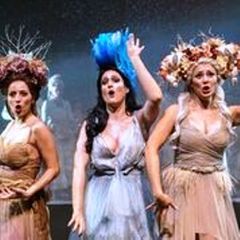|
Back
The Sun Alluringly Rises New York
Harlem Stage
05/04/2017 - & May 5, 6*, 7, 2017
Antonio Literes: Los Elementos
Samarie Alicea (Air), Melanie Ashkar (Earth), Chelsa Bonagura (Water), Kelsey Robertson (Fire), Magda Gartner (Dawn) Marco Nisticò (Time), Chorus: Lianne Gennaco, Rebecca Hargrove, Carolyn Ramseur, Makoto Winkler, Dancers: Esther Antoine, Adam Rogers
New York City Opera Orchestra, Yevgeia Strenger (Concertmaster), Pacien Mazzagatti (Music Director)
Richard Stafford (Stage Director and Choreographer), John Farrell (Scenic and Projection Design), Janet O’Neill (Costume Design), Shaun Kaufman (Lighting Desgn), Georgiana Eberhard (Wigs and Makeup Design)

M. Askhar, C. Bonagura, S. Alicea (© Susan Shatz)
New York City Opera is going for the rarest of the rare this year. Candide might be relatively popular, but its initial showing a rare failure Leonard Bernstein “opera/musical”, since Richard Wilbur’s poetry was too cerebral for New York audiences. The Respighi Sunken Bell last month was a welcome discovery, though this hybrid of glorious orchestration and a sumptuous production was tamed by too much ordinary verismo singing.
And now we have another hybrid from a composer who isn’t even listed in Groves Encyclopedia. Antonio Literes was a Spanish fiddler who owned a Strad, a composer of religious music, who probably hobnobbed with Domenico Scarlatti, and perhaps didn’t achieve what he wanted due to the chaotic political problems of the day.
All this information comes from the enlightening program notes by Antoni Pizà, but in the historical context, the 1702 production (with an anonymous librettist) was part of the times.
In England, The Elements, a mixture of dancing, singing and allegory, would have been called a Masque. In France, it would be a Royal entertainment like Charpentier’s Les Plaisirs de Versailles or Lully’s Atys, presented at the Morgan Library last November. Germany would soon call it a singspiel, and in Italy, Monteverdi produced some of these same Royal tableaux/ballets before going to Venice for his grand operas.
In The Elements, though, music was highly individual. If the story is almost commonplace, an extended example of Ben Johnson’s “comedy of humors”, if much of the music is Italianate for the time, he has added several decidedly Iberian elements. The use of castanets at the beginning and end, and the use of flamenco rhythms (beautifully choreographed by Richard Stafford) make this a special entertainment. True, Scarlatti used these rhythms for his sonatas, and Boccherini loved such sounds. But this early piece charms come from those idiosyncratic additions.
As with the Respighi opera, New York City Opera has given an opulent production for the slender 65-minute piece. The background changed with original projections. The arias by Water (Chelsea Bonsgura) were indeed swirling waters, those of fire (Kelsey Robertson) were of a raging fire. The fiery ligud duets combined the two. That of earth was a rolling globe. (A globe a bit too modern. One might have wanted an 18th Century picture of the earth, though this is trivializing).
The lighting was enchanting, the costumes by Janet O’Neil were overpoweringly opulent–the allegorical figures wearing gilded dress, the mortals dressed in the usual wigs. The whole production breathed an 18th Century aura, as well as a NYC Opera attention to detail.
Add to this an unusual orchestra which was sadly behind the scrim curtain. It might have detracted from the “play”, but I would love to have seen the Baroque harp, the guitar and Theorbo, and most of all, the viheula, a Moorish instrument taken over by the Spanish. Still, conductor/harpsichordist Pacien Mazzagatti led the ensemble on, never letting up for a second.
As to the performers, these varied, but that was almost incidental to the always-delightful style of the production. A constant delight were the two dancers, Esther Antoine and Adam Rogers, variegating classical ballet, Spanish steps, and, towards the end, a bit of modern rolling and shaking. (That might have seemed out of character, but how much character does one need in having several personified elements talking about how to get the sun to rise?)
The four-person chorus had some lovely choreography as well, and within the confines of the Harlem Stage, an ideal size for clarity of voice.
Among the principals, Ms. Robertson as Fire was certainly fiery enough, and in an auditorium of the most tricky acoustics, one could hear her without having to modify the sounds. Magda Gartner as the Dawn, another mezzo, was equally appealing, and her work at the end–sung and choreographed with a gentle elegance–was lovely., The other Elements had their moments in bel canto and melody, perhaps working too hard, perhaps not experienced enough.
Yet this was secondary to the production as a whole. For a relatively small stage, the crowded ensemble seemed to delight in all the movements, in the rollicking musical debates, (who makes the flowers grow, water or sunlight?) and in the welcome sunshine at the end.
Yes, we mortals might know that the sun always rises (save in rainy Manhattan this year), but listening to the simple poetry, embracing fragrances and winds, colors and birds, and looking at this showpiece abounding in creative riches, one could easily be transformed. Not entirely with particular elements, but the all-encompassing charm.
Harry Rolnck
|